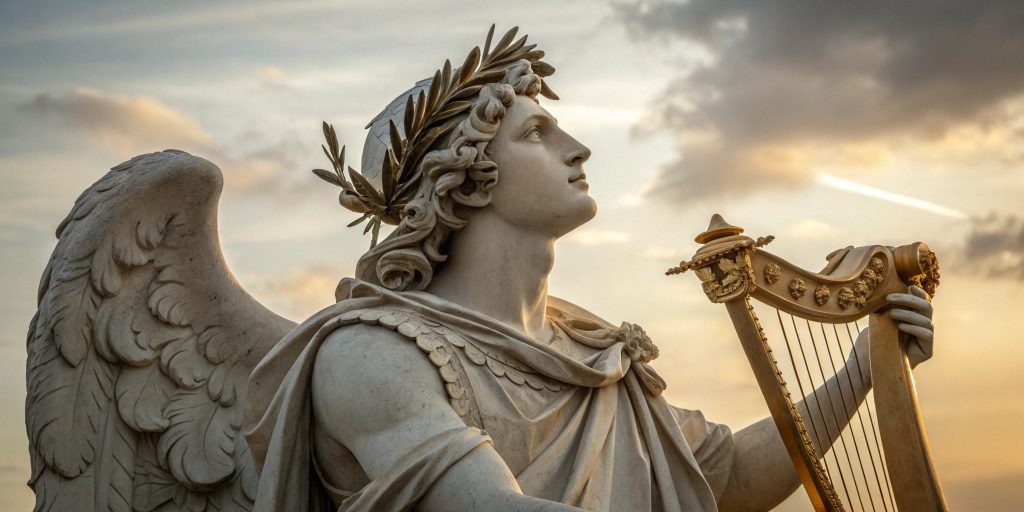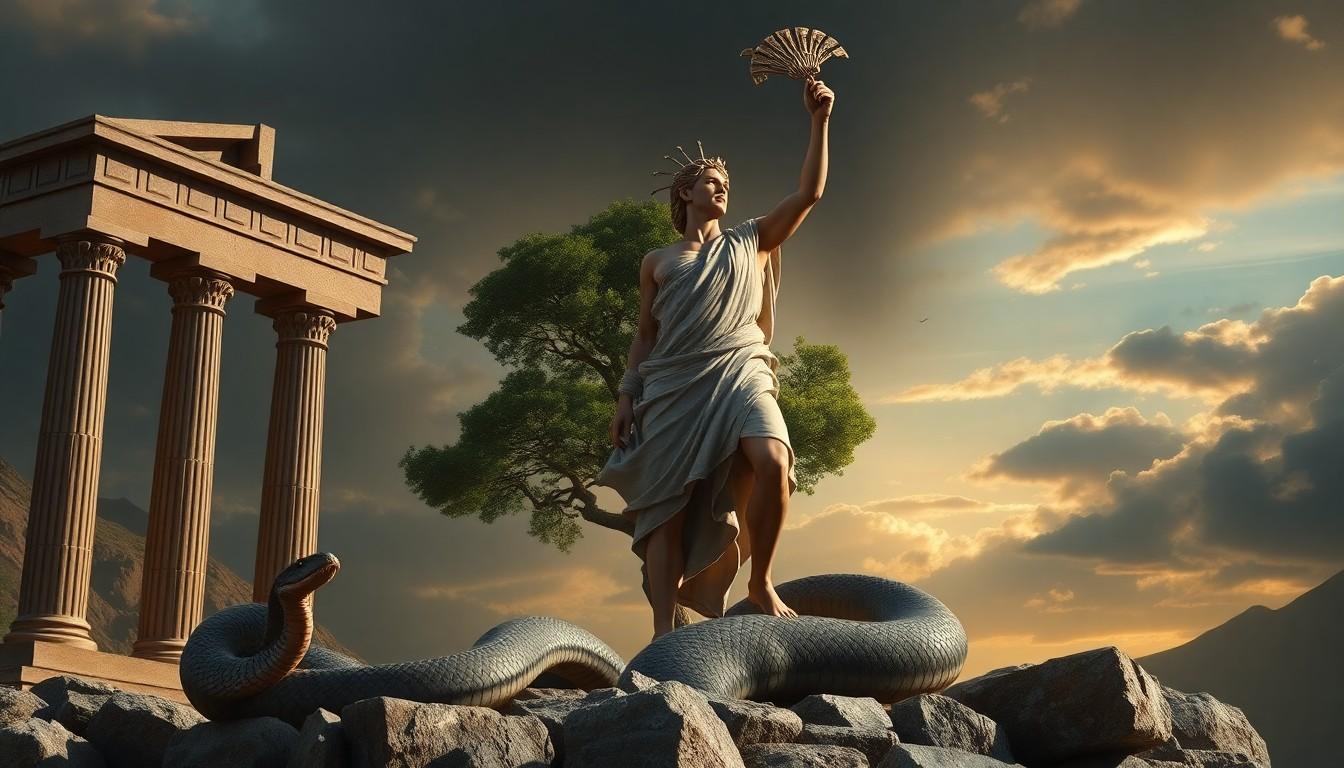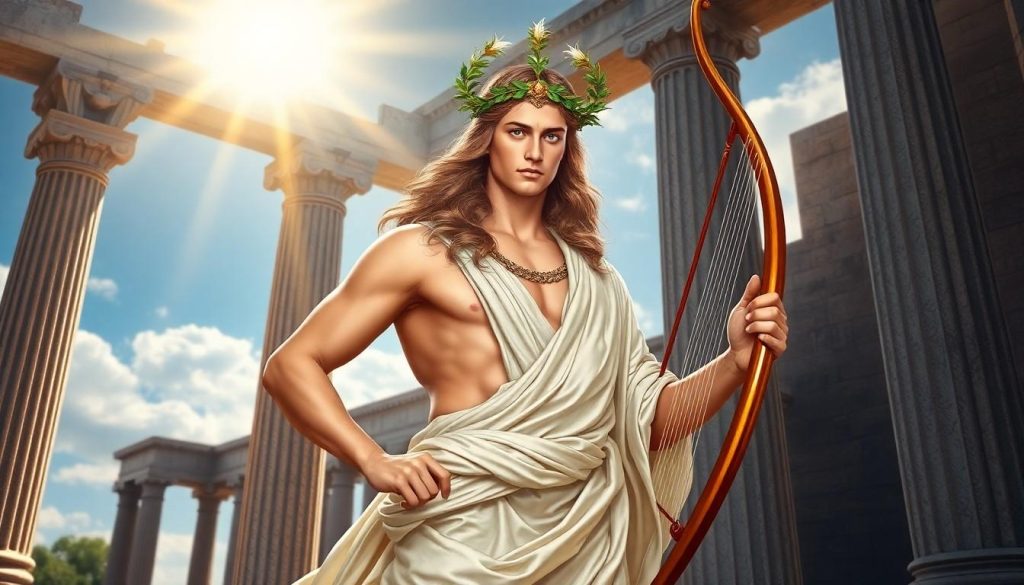Apollo is one of the most revered deities in Greek mythology. He embodies light, music, prophecy, and healing. As the son of Zeus and Leto, this powerful Olympian god wielded influence over multiple aspects of ancient Greek life and culture. His dual nature as both a nurturing healer and a deadly archer showcases the complex character that made him such a fascinating figure in mythology.
Through centuries of storytelling and artistic expression, Apollo’s legacy has remained a testament to the enduring impact of Greek mythology on modern culture. Apollo’s influence extended far beyond ancient Greece, from his famous oracle at Delphi to his role as the divine patron of music and poetry. Today, his name continues to inspire everything from space missions to artistic works, proving that the allure of this multifaceted god remains as powerful as ever.
Who Was Apollo in Greek Mythology
Apollo is one of the most powerful deities in Greek mythology. He embodies the domains of sunlight, healing, prophecy, music, and poetry. His divine influence extended across multiple aspects of ancient Greek life and culture through his diverse roles and attributes.
Apollo’s Divine Parents and Birth
Apollo’s parentage traces to Zeus, the king of gods Leto, a Titan goddess. Their union sparked the wrath of Zeus’s wife, Hera, forcing Leto to seek refuge on the floating island of Delos. The island anchored itself to provide sanctuary for Leto’s delivery of Apollo, his twin sister Artemis. Ancient texts record Apollo’s birth as a momentous event where the island burst into golden light, marking his emergence as a deity of radiance illumination.
- The Lyre: A stringed instrument symbolizing his mastery over music and poetry, gifted by Hermes
- The Bow Arrow: Representing his role as a divine archer, his ability to send plagues or healing
- The Sun Chariot: His vehicle for carrying the sun across the sky daily
- The Laurel Crown: A symbol of victory and artistic excellence derived from the nymph Daphne
- The Python: The serpent he slew at Delphi, establishing his oracle
- The Ravens: Sacred birds serving as his messengers observers
| Divine Domain | Associated Symbol | Significance |
|---|---|---|
| Music | Lyre | Artistic inspiration |
| Prophecy | Delphi Oracle | Divine knowledge |
| Healing | Serpent Staff | Medicine wisdom |
| Light | Sun Chariot | Solar deity status |
| Poetry | Laurel Crown | Artistic excellence |
Apollo’s Divine Powers and Domains

Apollo has multiple divine powers that span various domains in Greek mythology. His influence extends from celestial light to artistic expression and prophetic wisdom.
God of Light and the Sun
Apollo’s connection to light manifests through his role as the sun deity. He guides the sun chariot across the sky daily, bringing daylight to the world. During the Hellenistic period, Apollo merged with Helios, earning the title Apollo Helios to represent his complete embodiment of solar power.
God of Music, Poetry, and Arts
Apollo presides over musical arts as the divine patron of harmony. He invented the lyre, establishing his mastery over stringed instruments. As leader of the Nine Muses, Apollo oversees:
- Musical performances through instrumental mastery
- Poetic compositions for religious ceremonies
- Dance choreography during cultural festivals
- Artistic celebrations in ancient Greek society
- The divine interpreter of Zeus’s will
- A source of wisdom for ancient Greek leaders
- The patron of prophetic visions
- A guide for essential decisions in Greek society
Notable Myths and Stories About Apollo

Apollo’s mythological narrative includes significant tales showcasing his power, influence, and complex relationships with mortals and immortals. These stories demonstrate his multifaceted nature as a deity who embodies both creation and destruction.
The Python of Delphi
Apollo’s confrontation with the Python marks a defining moment in Greek mythology. After his birth on Delos, Apollo traveled to Delphi, where he encountered the massive serpent Python, who had previously terrorized his mother, Leto, during her pregnancy. Apollo slew the Python with 100 precise arrows, claiming the sacred site of Delphi as his own. Following this victory, Apollo established the Oracle of Delphi by transforming into a dolphin to guide Cretan sailors to the location, leading to the site’s name derived from delphis (dolphin).
Apollo and Daphne
The tale of Apollo and Daphne represents a pivotal story of unrequited love in Greek mythology. Struck by Eros’s golden arrow, Apollo became enamored with the nymph Daphne while she was simultaneously hit with a lead arrow that made her reject his advances. As Apollo pursued Daphne, she pleaded with her father, the river god Peneus, for help. Peneus transformed her into a laurel tree moments before Apollo could catch her. In his grief, Apollo made the laurel his sacred plant, using its leaves to create the crown symbolizing poetic and athletic achievement.
Apollo’s Most Famous Temples and Sanctuaries

Apollo’s sanctuaries showcased his divine authority through architectural magnificence and sacred rituals. These religious centers served as gathering places for worship devotees seeking prophecy guidance throughout ancient Greece.
The Oracle of Delphi
The Oracle of Delphi stands as Apollo’s most influential sanctuary, built where he slayed the serpent Python. The Pythia, a woman over 50 years old, delivered prophetic messages in Apollo’s main temple while priests interpreted her cryptic utterances into verse form. This sacred site earned its name after Apollo transformed into a dolphin (delphis) and guided Cretan sailors to establish his sanctuary.
Temple of Apollo at Didyma
The Temple of Apollo at Didyma ranked second to Delphi in religious significance. Located near modern-day Turkey, this massive temple complex features:
- Double colonnade of 122 ionic columns
- Sacred spring where oracles received divine messages
- Three-story inner sanctum called the Adyton
- Bronze doors decorated with Medusa heads
- Central courtyard measuring 100 feet square
| Temple Feature | Measurement |
|---|---|
| Column Height | 62 feet |
| Temple Width | 157 feet |
| Temple Length | 303 feet |
| Construction Period | 494-281 BCE |
The sanctuary operated continuously for over 1,000 years until it was destroyed by Christian forces in 385 CE. Priests, the Branchidae, maintained this oracular site dedicated to Apollo and his twin sister Artemis.
Apollo’s Influence on Ancient Greek Culture
Apollo’s cultural impact manifested through three primary domains that shaped ancient Greek society: artistic expression, prophetic guidance, and medical practices.
Artistic Leadership
Apollo’s mastery of music and poetry established him as the leader of the Nine Muses. His invention of the lyre revolutionized Greek musical traditions, creating a foundation for classical performances. Artists, musicians, and poets sought Apollo’s inspiration through:
- Musical competitions at religious festivals
- Poetic recitations in amphitheaters
- Dance ceremonies honoring divine achievements
- Creative performances at sacred temples
Oracular Authority
The Oracle of Delphi, Apollo’s most significant prophetic center, influenced major political and personal decisions across the Greek world. The Oracle’s impact included:
- State policy formation
- Military campaign planning
- Religious ceremony timing
- Personal life guidance
Medical Innovation
Apollo’s association with healing shaped Greek medical practices through:
- Establishment of healing sanctuaries
- Development of herbal remedies
- Training of medical practitioners
- Integration of music therapy
| Domain | Cultural Impact | Notable Examples |
|---|---|---|
| Arts | Creative Expression | Lyre invention, Muse leadership |
| Prophecy | Decision Making | Delphic Oracle consultations |
| Medicine | Health Practices | Asclepius healing traditions |
Apollo’s artistic patronage, prophetic authority, and healing knowledge created lasting institutions that defined Greek cultural development. His temples served as centers for creative performance, political consultation, and medical treatment, establishing practices that influenced Mediterranean civilization for centuries.
Apollo’s Legacy in Modern Times
Apollo’s influence spans diverse areas of contemporary culture, particularly in the arts, medicine, and scientific fields.
Cultural and Artistic Influence
Apollo’s association with artistic expression shapes modern creative disciplines. The term “Apollonian” characterizes the qualities of:
- Order in architectural design
- Harmony in musical compositions
- Balance in visual arts
- Precision in poetic forms
- Symmetry in Aesthetic Principles
Medical and Scientific Fields
The medical profession preserves Apollo’s healing legacy through symbolic representations:
| Symbol | Origin | Modern Usage |
|---|---|---|
| Rod of Asclepius | Apollo’s son Asclepius | Official emblem of medical organizations |
| Single serpent staff | Ancient healing symbol | Healthcare facility logos |
| Medical caduceus | Alternative medical symbol | Professional medical associations |
Medical institutions integrate these Apollonian symbols in:
- Hospital logos
- Medical association emblems
- Healthcare facility branding
- Professional medical certifications
- Pharmaceutical company designs
These enduring symbols connect modern healthcare practices to Apollo’s ancient role as a healing deity, reinforcing the profession’s commitment to wellness and medical advancement.
Conclusion
Apollo is one of the most influential deities in Greek mythology, and his impact resonates through time. His multifaceted nature as a god of light music, prophecy, and healing profoundly shaped ancient Greek society. Apollo’s divine influence established enduring institutions and cultural practices, from the sacred Oracle at Delphi to his patronage of the arts.
Apollo’s legacy lives on today through modern art, literature, and medicine interpretations. His harmony, balance, and precision inspire creative works, while his connection to healing remains evident in medical symbols worldwide. The enduring appeal of Apollo’s mythology demonstrates the timeless relevance of his divine attributes to human civilization.

